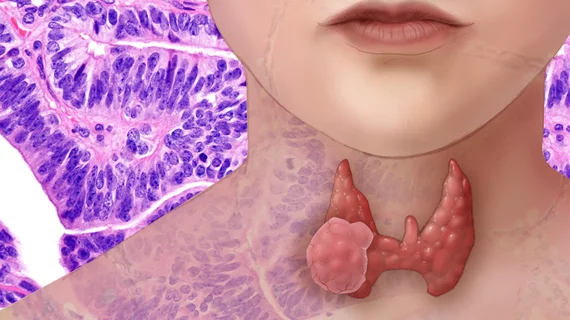Optoacoustic imaging can noninvasively diagnose thyroid disorders
Pairing multispectral optoacoustic tomography (MSOT) with ultrasound can improve radiologists’ diagnosis of thyroid diseases, according to a new pilot study published in the Journal of Nuclear Medicine.
Researchers based in Germany and the U.K. found the combined imaging method could noninvasively provide biomarker information for autoimmune diseases and thyroid nodules, which affect about 20 million Americans.
"Currently, evaluation and risk stratification methods for thyroid disorders include hormone testing, high-resolution ultrasound, scintigraphy and invasive procedures––fine needle aspiration biopsy and thyroidectomy," Wolfgang Roll, MD, physician at the University Hospital Münster’s Department of Nuclear Medicine, said in a statement. “Our study set out to evaluate if hybrid MSOT/ultrasound imaging might provide new biomarkers to further assess risk patterns for individual thyroid nodules without the need for invasive procedures.”
MSOT detects ultrasonic waves created when ultrashort laser pulses causes tissue to expand; it’s been successfully used in vascular imaging, inflammatory bowel diseases and oncology.
Roll and colleagues enrolled 18 patients in their study: three with Graves’ disease (which causes inflammation of thyroid glands), three with malignant thyroid nodules, nine with benign thyroid nodules and three healthy participants. All patients underwent routine thyroid evaluation according to international guidelines.
The researchers looked and multiple biomarkers and tissue parameters in MSOT images including: deoxygenated hemoglobin, oxygenated hemoglobin, total hemoglobin, saturation of hemoglobin, fat content and water content.
In MSOT/ultrasound images of those with Graves’ diseases, deoxygenated hemoglobin and total hemoglobin were much higher compared to healthy controls. Fat content was also markedly lower in the former group. Additionally, images of malignant thyroid nodules showed lower saturation of hemoglobin and lower fat content compared to benign nodules.
MSOT imaging is still “prone” to artifacts and more research will be needed to confirm the results, but the researchers believe MOST/ultrasound imaging could eventually be used in clinical practice.
“Optoacoustic imaging is a new opportunity to employ optical imaging for deep tissue analyses with potential clinical applications in various benign and malignant disease," Roll stated. "Our study has shown that hybrid MSOT/ultrasound can assess changes in tissue composition in thyroid disorders by providing semiquantitative functional parameters noninvasively.
With additional preclinical and clinical translational research, these technical developments can help to improve diagnostics and assessment of therapy response in the future."

